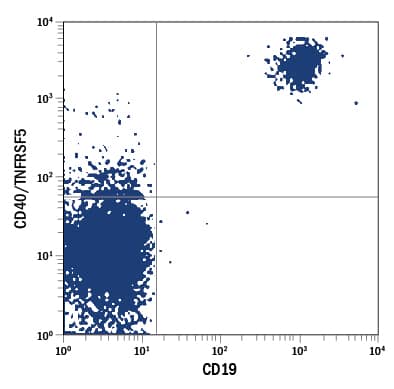Human CD40/TNFRSF5 APC-conjugated Antibody
R&D Systems, part of Bio-Techne | Catalog # FAB6321A


Key Product Details
Species Reactivity
Applications
Label
Antibody Source
Product Specifications
Immunogen
Glu21-Arg193
Accession # P25942
Specificity
Clonality
Host
Isotype
Scientific Data Images for Human CD40/TNFRSF5 APC-conjugated Antibody
Detection of CD40/TNFRSF5 in Human Blood Lymphocytes by Flow Cytometry.
Human peripheral blood lymphocytes were stained with Mouse Anti-Human CD40/TNFRSF5 APC-conjugated Monoclonal Antibody (Catalog # FAB6321A) and Mouse Anti-Human CD19 PE-conjugated Monoclonal Antibody (Catalog # FAB4867P). Quadrant markers were set based on control antibody staining. View our protocol for Staining Membrane-associated Proteins.Detection of CD40/TNFRSF5 in PBMC lymphocytes by Flow Cytometry
PBMC lymphocytes were stained with Mouse Anti-Human CD19 PE-conjugated Monoclonal Antibody (Catalog # FAB4867P) and either (A) Mouse Anti-Human CD40/TNFRSF5 APC-conjugated Monoclonal Antibody (Catalog # FAB6321A) or (B) isotype control antibody (Catalog # IC0041A). View our protocol for Staining Membrane-associated Proteins.Applications for Human CD40/TNFRSF5 APC-conjugated Antibody
Flow Cytometry
Sample: Human peripheral blood lymphocytes
Formulation, Preparation, and Storage
Purification
Formulation
Shipping
Stability & Storage
- 12 months from date of receipt, 2 to 8 °C as supplied.
Background: CD40/TNFRSF5
CD40 is a type I transmembrane glycoprotein belonging to the TNF receptor superfamily. The mature hCD40 consists of a 172 amino acid (aa) extracellular domain, a 22 aa transmembrane region and a 62 aa cytoplasmic domain (1). Human and mouse CD40 share 62% aa identity. CD40 is expressed in B cells, follicular dendritic cells, dendritic cells, activated monocytes, macrophages, endothelial cells, vascular smooth muscle cells, and several tumor cell lines (2). The extracellular domain has the cysteine-rich repeat regions, which are characteristic for many of the receptors of the TNF superfamily. Interaction of CD40 with its ligand, CD40L, leads to aggregation of CD40 molecules, which in turn interact with cytoplasmic components to initiate signaling pathways. Early studies on the CD40-CD40L system revealed its role in humoral immunity. Interaction between CD40L on T cells and CD40 on B cells stimulated B cell proliferation and provided the signal for immunoglobulin isotype switching (3). Mutations in the CD40L gene, which resulted in a CD40L molecule unable to interact with CD40, are responsible for the hyper-IgM syndrome (4). Cross-linking of CD40 with antibodies or by CD40 binding to CD40L produces cell type-specific responses which include costimulation and induction of proliferation, induction of cytokine production, rescue from apoptosis, and upregulation of adhesion molecules (5). Some of the early events of intracellular signaling by the CD40‑CD40L system include the association of the CD40 with TRAFs and the activation of various kinases (6‑8).
References
- Torres, R.M. and E.A. Clark (1992) J. Immunol. 148:620.
- Schonbeck, U. et al. (1997) J. Biol. Chem. 272:19569.
- Armitage, R.J. et al. (1993) J. Immunol. 150:3671.
- Callard, R.E. et al. (1993) Immunol. Today 14:559.
- Stout, R.D. and J. Suttles (1996) Immunol. Today 17:487.
- Pullen, S.S. et al. (1999) Biochemistry 38:10168.
- Faris, M. et al. (1994) J. Exp. Med. 179:1923.
- Hanissian, S.H. and R.S Geha (1997) Immunity 6:379.
Alternate Names
Gene Symbol
UniProt
Additional CD40/TNFRSF5 Products
Product Documents for Human CD40/TNFRSF5 APC-conjugated Antibody
Product Specific Notices for Human CD40/TNFRSF5 APC-conjugated Antibody
For research use only
